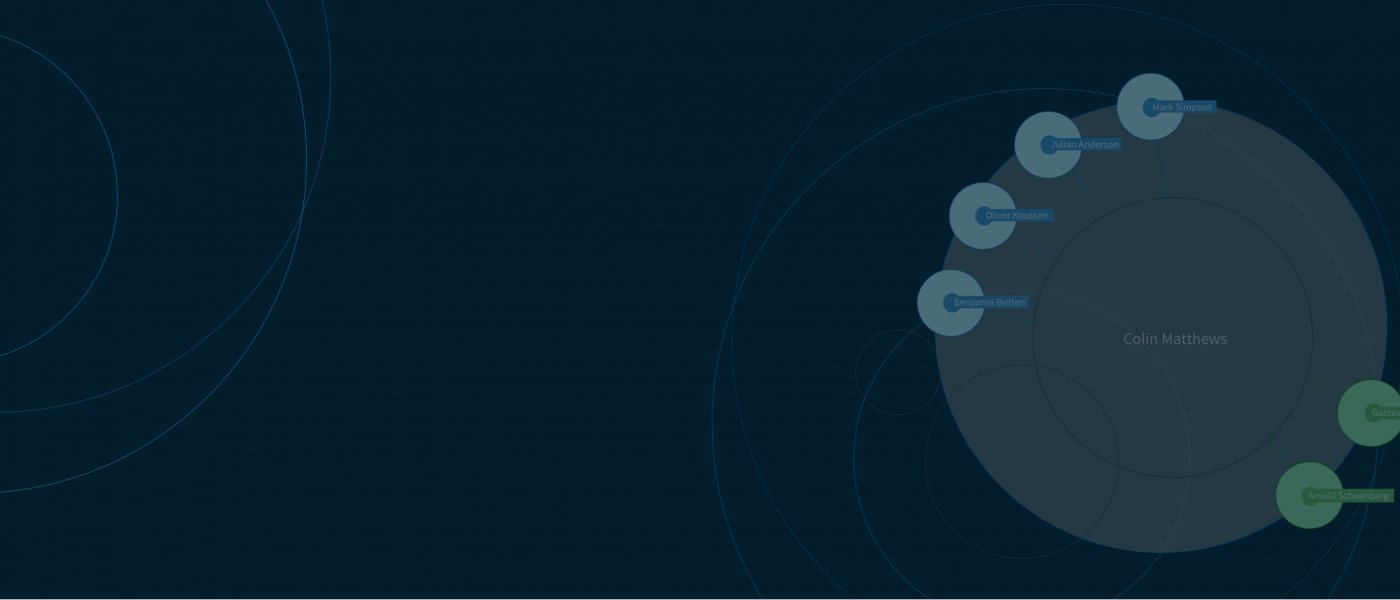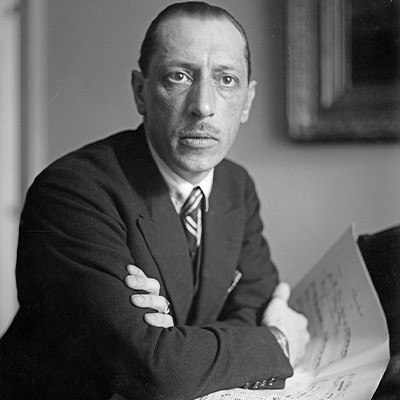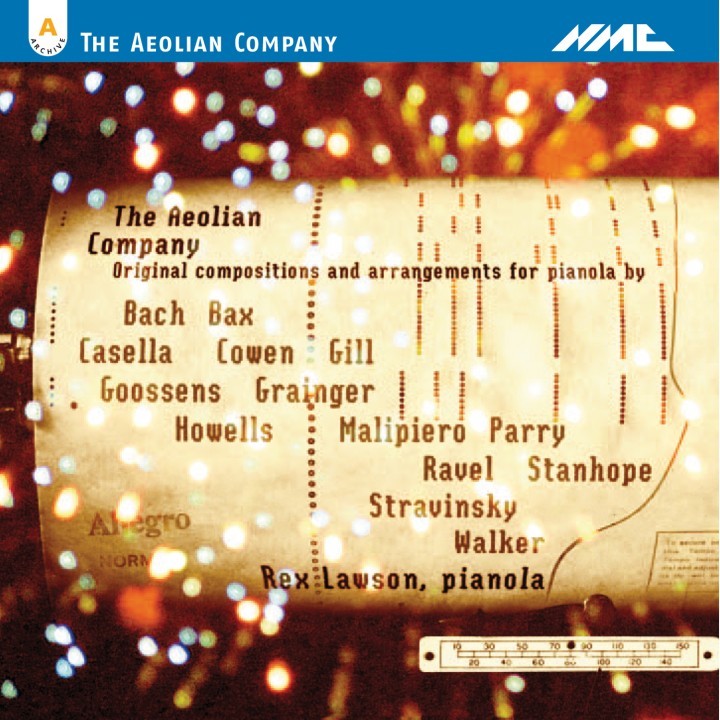Igor Stravinsky
Igor Feodorovich Stravinsky was born in Oranienbaum (now Lomonosov), a Baltic resort near St Petersburg, in 1882. Stravinsky's musical education began with piano lessons at home when he was ten; he later studied law at St Petersburg University, and music theory; but his most important teacher was Nikolay Rimsky-Korsakov, with whom he studied from 1905 until 1908.
Although his first substantial composition was a Symphony in E flat (1906), it was The Firebird, a ballet commissioned by Sergei Diaghilev and premiered by his Ballets Russes in Paris in 1910, that brought Stravinsky into sudden international prominence. In the next year he consolidated his reputation with Petrushka, like The Firebird a transformation of something essentially Russian into a work of surprising modernity. Stravinsky's next major score - a third ballet commission from Diaghilev - is one of the major landmarks in the history of music: the blend of melodic primitivism and rhythmic complexity in The Rite of Spring marked the coming of modernism in music and was met with a mixture of astonishment and hostility. Stravinsky, now a Swiss resident, became established, as the most radical composer of the age.
A rapid succession of works - The Nightingale, an opera, in 1914, Renard in 1915, The Soldier's Tale in 1918, the Symphonies of Wind Instruments two years after that - all reinforced his aesthetic dominance. The explicitly Russian flavour of his music - played out in the Symphonies of Wind Instruments (1920), the opera buffa Mavra (1922) and Les Noces (1923), for four solo voices, chorus and an orchestra consisting of four pianos and percussion - now gave way to a more refined neo-classicism, beginning with the ballet Pulcinella (1920), for which Stravinsky went back to the music of Pergolesi, reworking it into something completely personal.
1920 was also the year that Stravinsky settled in France, taking French citizenship in 1934. However after the deaths of his daughter and his wife, and faced with an imminent war in Europe, Stravinsky and his second-wife-to-be Vera Sudeikin emigrated to the United States. After a year spent on the East Coast, he and Vera soon settled in California, which they were to make their home for the rest of their lives.
Pulcinella turned out to be only the first of many works in which, over the next two decades, Stravinsky subdued the music of the past to his own purposes. Two choral-orchestral works - the oratorio Oedipus Rex (1927) and the Symphony of Psalms (1930) - showed that he could also work on an epic scale; and it was not long before he tackled a purely orchestral Symphony in C (1938), which was followed within four years by the Symphony in Three Movements. Stravinsky's neo-classical period culminated in 1951 in his three-act opera The Rake's Progress, to a libretto by W.H. Auden and Chester Kallman.
One of the most unexpected stylistic volte-faces in modern music came in 1957, with the appearance of the ballet Agon; Stravinsky himself conducted its premiere at a 75th-birthday concert. Hitherto he had ignored Schoenbergian serialism, but in 1952 he began to study Webern's music intensely and Agon was the first work in which he embraced serialism wholeheartedly. The chief works from Stravinsky's late serial flowering include Threni, for six solo voices, chorus and orchestra (1958) and Requiem Canticles (1966).
Stravinsky was also active as a performer of his own music, initially as a pianist but increasingly as a conductor. The first among contemporary composers to do so, he left a near-complete legacy of recordings of his own music, released on CBS. His conducting career continued until 1967, when advancing age and illness forced him to retire from the concert platform. His tenuous grasp on life finally broke on 6 April 1971, in New York, and his body was flown to Venice for burial on the island of San Michele, near to the grave of Diaghilev.
Igor Feodorovich Stravinsky was born in Oranienbaum (now Lomonosov), a Baltic resort near St Petersburg, in 1882. Stravinsky's musical education began with piano lessons at home when he was ten; he later studied law at St Petersburg University, and music theory; but his most important teacher was Nikolay Rimsky-Korsakov, with whom he studied from 1905 until 1908.
Although his first substantial composition was a Symphony in E flat (1906), it was The Firebird, a ballet commissioned by Sergei Diaghilev and premiered by his Ballets Russes in Paris in 1910, that brought Stravinsky into sudden international prominence. In the next year he consolidated his reputation with Petrushka, like The Firebird a transformation of something essentially Russian into a work of surprising modernity. Stravinsky's next major score - a third ballet commission from Diaghilev - is one of the major landmarks in the history of music: the blend of melodic primitivism and rhythmic complexity in The Rite of Spring marked the coming of modernism in music and was met with a mixture of astonishment and hostility. Stravinsky, now a Swiss resident, became established, as the most radical composer of the age.
A rapid succession of works - The Nightingale, an opera, in 1914, Renard in 1915, The Soldier's Tale in 1918, the Symphonies of Wind Instruments two years after that - all reinforced his aesthetic dominance. The explicitly Russian flavour of his music - played out in the Symphonies of Wind Instruments (1920), the opera buffa Mavra (1922) and Les Noces (1923), for four solo voices, chorus and an orchestra consisting of four pianos and percussion - now gave way to a more refined neo-classicism, beginning with the ballet Pulcinella (1920), for which Stravinsky went back to the music of Pergolesi, reworking it into something completely personal.
1920 was also the year that Stravinsky settled in France, taking French citizenship in 1934. However after the deaths of his daughter and his wife, and faced with an imminent war in Europe, Stravinsky and his second-wife-to-be Vera Sudeikin emigrated to the United States. After a year spent on the East Coast, he and Vera soon settled in California, which they were to make their home for the rest of their lives.
Pulcinella turned out to be only the first of many works in which, over the next two decades, Stravinsky subdued the music of the past to his own purposes. Two choral-orchestral works - the oratorio Oedipus Rex (1927) and the Symphony of Psalms (1930) - showed that he could also work on an epic scale; and it was not long before he tackled a purely orchestral Symphony in C (1938), which was followed within four years by the Symphony in Three Movements. Stravinsky's neo-classical period culminated in 1951 in his three-act opera The Rake's Progress, to a libretto by W.H. Auden and Chester Kallman.
One of the most unexpected stylistic volte-faces in modern music came in 1957, with the appearance of the ballet Agon; Stravinsky himself conducted its premiere at a 75th-birthday concert. Hitherto he had ignored Schoenbergian serialism, but in 1952 he began to study Webern's music intensely and Agon was the first work in which he embraced serialism wholeheartedly. The chief works from Stravinsky's late serial flowering include Threni, for six solo voices, chorus and orchestra (1958) and Requiem Canticles (1966).
Stravinsky was also active as a performer of his own music, initially as a pianist but increasingly as a conductor. The first among contemporary composers to do so, he left a near-complete legacy of recordings of his own music, released on CBS. His conducting career continued until 1967, when advancing age and illness forced him to retire from the concert platform. His tenuous grasp on life finally broke on 6 April 1971, in New York, and his body was flown to Venice for burial on the island of San Michele, near to the grave of Diaghilev.
Compilations with this composer
CompilationsRelated composers
Related composersExternal Links
Music Map
Discover more about the classical music of today with NMC's Music Map, and exciting and educational online tool which enables you to see and hear the connections between composers, their teachers, pupils, influences and their works.
Music Map

